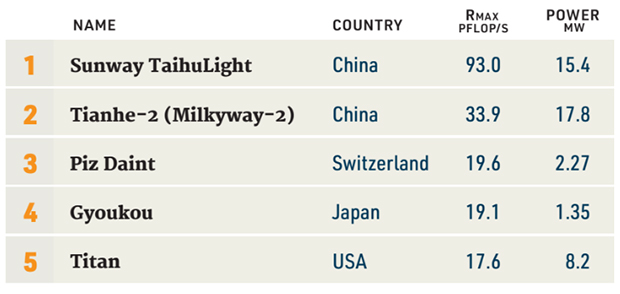Latest TOP500 List Shows China Surpassing U.S.
Latest News
November 14, 2017
The 50th TOP500 list of the fastest supercomputers in the world has China overtaking the U.S. in the total number of ranked systems by a margin of 202 to 143. It is the largest number of supercomputers China has ever claimed on the TOP500 ranking, with the U.S. presence shrinking to its lowest level since the list’s inception 25 years ago.
Just six months ago, the U.S. led with 169 systems, with China coming in at 160. Despite the reversal of fortunes, the 143 systems claimed by the U.S. gives them a solid second-place finish, with Japan in third place with 35, followed by Germany with 20, France with 18 and the UK with 15.
China has also overtaken the U.S. in aggregate performance as well. The Asian superpower now claims 35.4% of the TOP500 flops, with the U.S. in second place with 29.6%.
The top 10 systems remain largely unchanged since the June 2017 list, with a couple of notable exceptions.
Sunway TaihuLight, a system developed by China’s National Research Center of Parallel Computer Engineering & Technology (NRCPC), and installed at the National Supercomputing Center in Wuxi, maintains its No. 1 ranking for the fourth time, with a High Performance Linpack (HPL) mark of 93.01 petaflops.
Tianhe-2 (Milky Way-2), a system developed by China’s National University of Defense Technology (NUDT) and deployed at the National Supercomputer Center in Guangzho, China, is still the No. 2 system at 33.86 petaflops.
Piz Daint, a Cray XC50 system installed at the Swiss National Supercomputing Centre (CSCS) in Lugano, Switzerland, maintains its No. 3 position with 19.59 petaflops, reaffirming its status as the most powerful supercomputer in Europe. Piz Daint was upgraded last year with NVIDIA Tesla P100 GPUs, which more than doubled its HPL performance of 9.77 petaflops.
The new No. 4 system is the upgraded Gyoukou supercomputer, a ZettaScaler-2.2 system deployed at Japan’s Agency for Marine-Earth Science and Technology, which was the home of the Earth Simulator. Gyoukou was able to achieve an HPL result of 19.14 petaflops. using PEZY-SC2 accelerators, along with conventional Intel Xeon processors. The system’s 19,860,000 cores represent the highest level of concurrency ever recorded on the TOP500 rankings of supercomputers.
Titan, a five-year-old Cray XK7 system installed at the Department of Energy’s (DOE) Oak Ridge National Laboratory, and still the largest system in the U.S., slips down to No. 5. Its 17.59 petaflops are mainly the result of its NVIDIA K20x GPU accelerators.
Sequoia, an IBM BlueGene/Q system installed at DOE’s Lawrence Livermore National Laboratory, is the No. 6 system on the list with a mark of 17.17 petaflops. It was deployed in 2011.
The new No. 7 system is Trinity, a Cray XC40 supercomputer operated by Los Alamos National Laboratory and Sandia National Laboratories. It was recently upgraded with Intel “Knights Landing” Xeon Phi processors, which propelled it from 8.10 petaflops six months ago to its current high-water mark of 14.14 petaflops.
Cori, a Cray XC40 supercomputer, installed at the National Energy Research Scientific Computing Center (NERSC), is now the eighth fastest supercomputer in the world. Its 1,630 Intel Xeon “Haswell” processor nodes and 9,300 Intel Xeon Phi 7250 nodes yielded an HPL result of 14.01 petaflops.
At 13.55 petaflops, Oakforest-PACS, a Fujitsu PRIMERGY CX1640 M1 installed at Joint Center for Advanced High Performance Computing in Japan, is the No. 9 system. It too is powered by Intel “Knights Landing” Xeon Phi processors.
Fujitsu’s K computer installed at the RIKEN Advanced Institute for Computational Science (AICS) in Kobe, Japan, is now the No. 10 system at 10.51 petaflops. Its performance is derived from its 88 thousand SPARC64 processor cores linked by Fujitsu’s Tofu interconnect. Despite its 10th-place showing on HPL, the K Computer is the top-ranked system on the High-Performance Conjugate Gradients (HPCG) benchmark.
For the first time, each of the top 10 supercomputers delivered more than 10 petaflops on HPL. There are also 181 systems with performance greater than a petaflop–up from 138 on the June 2017 list. The combined performance of all 500 systems has grown to 845 petaflops, compared with 749 petaflops six months ago and 672 petaflops one year ago. Even though aggregate performance grew by nearly 100 petaflops, the relative increase is well below the list’s long-term historical trend.
A further reflection of this slowdown is the list turnover. The entry point in the latest rankings moved up to 548 teraflops, compared to 432 teraflops in June. The 548-teraflop system was in position 370 in the previous TOP500 list. The turnover is in line with what has been observed over the last four years, but is much lower than previous levels.
A total of 102 systems employ accelerator/coprocessor technology, compared with 91 six months ago. 86 of these use NVIDIA GPUs, 12 systems make use Intel Xeon Phi coprocessor technology, and 5 are using PEZY Computing accelerators. Two systems use a combination of NVIDIA GPU and Intel Xeon Phi coprocessors. An additional 14 systems now use Xeon Phi chips as the main processing unit.
For more info, TOP500.
Sources: Press materials received from the company.
Subscribe to our FREE magazine, FREE email newsletters or both!
Latest News






